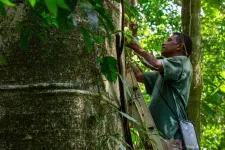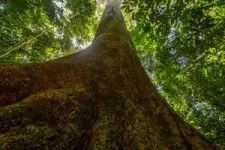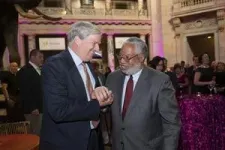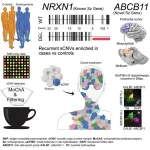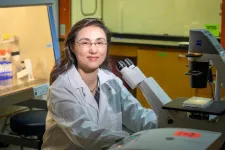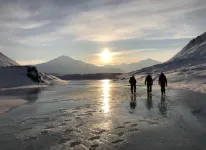(Press-News.org) By conserving and replanting forests, the world buys time until it brings other climate and sustainability solutions online. As a critical step toward this goal, the Smithsonian Tropical Research Institute (STRI) received a $12 million grant from the Bezos Earth Fund to support GEO-TREES. This international consortium is the first worldwide system to independently ensure the accuracy of satellite monitoring of forest biomass—a way to measure carbon stored in trees—in all forest types and conditions. The GEO-TREES alliance offers a freely accessible database that integrates on-the-ground measurements of individual trees with terrestrial and aerial laser scans (LiDAR) of forests—a highly accurate way to verify forest carbon estimates based on satellite images.
“The GEO-TREES project is as exciting as it is essential for our detailed understanding of the interplay between tropical forests and carbon capture,” said Smithsonian Secretary Lonnie Bunch. “Scientific research has been at the heart of the Smithsonian’s mission for more than 176 years, and the grant from the Bezos Earth Fund demonstrates the value of support and collaboration in the search for solutions to our planet’s shared challenges.”
“The Bezos Earth Fund is pleased to support and partner on this powerful project to use decades of long-term data to understand forest carbon,” said Cristián Samper, managing director and leader for nature solutions at the Bezos Earth Fund. “There are very few places like the Smithsonian Tropical Research Institute, where the tropical rainforest has been studied for 100 years. The longevity of tropical research at the Smithsonian, together with the expansion of a global network of forest study sites, will help address the climate crisis we face in a way not possible anywhere else.”
At the heart of the GEO-TREES system is the Smithsonian’s ForestGEO network, directed by STRI staff scientist, Stuart Davies, working closely with partners around the globe. With 40 years’ experience rooted in the tropics, ForestGEO is the most extensive, long-term, large-scale, forest-monitoring network in the world, representing researchers at 76 study sites in 29 countries. The ForestGEO project is distinguished by its emphasis on partnership, incorporating the need for data with local conservation and management goals.
Space agencies worldwide are putting satellites into orbit to image forests in real time, but for scientists to verify carbon-storage numbers from these images, they must calibrate the satellite measurements against high-quality ground-based measurements. To gather high-quality measurements, scientists are intensively studying forest biomass reference sites in mature and younger forests, leveraging several partner forest-plot networks.
Most of the grant will be spent in tropical countries—many of them middle- and low-income—not only for data collection, but to strengthen capacity for local stakeholders and early-career scientists. This effort will enable them to combine field data collection with cutting-edge technology to monitor and evaluate the carbon stored in their forests.
“Tropical forests are the most important, best-understood, carbon-capture devices in the world,” said Joshua Tewksbury, director of STRI, which will administer the funds via its ForestGEO program. “But to make large-scale carbon capture a reality, we need to engage all sectors of society. And we can only do that if we can clearly show where the carbon is—and how carbon stocks change in real time, at scales that landowners, countries and investors care about. The Smithsonian, with hundreds of partners around the world, has taken on the challenge of providing the definitive ground-based global forest database to make this work possible.”
Each tree species in the world is unique: a balsa tree’s soft wood stores much less carbon than an ebony or rosewood tree’s dense wood. The age of each forest and the species present—which vary wildly from place to place—affect how much carbon is stored. Trees absorb different amounts of carbon on sunny days compared with cloudy days, and carbon storage depends on available water and nutrients. Thus, quantifying the biomass of complex forests requires significant expertise.
“The Smithsonian recently launched Life on a Sustainable Planet, which harnesses all Smithsonian resources to focus on solutions for our changing planet,” said Ellen Stofan, Under Secretary for Science and Research at the Smithsonian Institution. “The GEO-TREES project is a major component of that effort, and this grant from the Bezos Earth Fund helps us take a significant step forward in strengthening connections between people and nature.”
STRI, headquartered in Panama City, Panama, is a unit of the Smithsonian. The institute furthers the understanding of tropical biodiversity and its importance to human welfare, trains students to conduct research in the tropics and promotes conservation by increasing public awareness of the beauty and importance of tropical ecosystems. Watch STRI’s video and visit the institute on its website and on Facebook, Twitter and Instagram for updates.
END
Bezos Earth Fund grants $12 million to Smithsonian to support major forest carbon project
Science-based carbon storage biomass verification
2023-07-06
ELSE PRESS RELEASES FROM THIS DATE:
Legends of Norse Settlers drove Denmark towards Greenland
2023-07-06
In 985, Viking explorer Erik the Red led a group of Icelandic farmers to Greenland, where they established a settlement on the west coast. Archaeological evidence suggests that the settlement existed for over 400 years, but the impact of the settlement lasted much longer. It is little recognised today that the hope of finding the descendants of the settlers dominated European and American perspectives on Greenland for centuries
In his new book The Vanished Settlers of Greenland: In Search of a Legend and Its Legacy, Associate Professor Robert Rix argues that the lost Norse settlement played a decisive ...
Archaeology: The power of the Copper Age 'Ivory Lady' revealed
2023-07-06
The highest status individual in ancient Copper Age society in Iberia, was a woman and not a man as previously thought, according to peptide analysis reported in Scientific Reports. The individual, now re-dubbed the 'Ivory Lady', was buried in a tomb filled with the largest collection of rare and valuable items in the region, including ivory tusks, high-quality flint, ostrich eggshell, amber, and a rock crystal dagger. These findings reveal the high status women could hold in this ancient society.
In 2008, an individual was discovered in a tomb in Valencia, Spain dating to the Copper Age between 3,200 and 2,200 years ago. As well as being a rare example of a single occupancy ...
Schizophrenia is associated with somatic mutations occurring in utero
2023-07-06
As a psychiatric disorder with onset in adulthood, schizophrenia is thought to be triggered by some combination of environmental factors and genetics, although the exact cause is still not fully understood. In a study published in the journal Cell Genomics on July 6, researchers find a correlation between schizophrenia and somatic copy-number variants, a type of mutation that occurs early in development but after genetic material is inherited. This study is one of the first to rigorously describe the relationship between somatic—not inherited—genetic mutations and schizophrenia risk.
“We originally thought of genetics as the study of inheritance. But now we ...
Team develops all-species coronavirus test
2023-07-06
CHAMPAIGN, Ill. — In an advance that will help scientists track coronavirus variants in wild and domesticated animals, researchers report they can now detect exposure to the SARS-CoV-2 virus in any animal species. Most coronavirus antibody tests require specialized chemical reagents to detect host antibody responses against the virus in each species tested, impeding research across species.
The virus that causes COVID-19 in humans also infects a variety of animals, said University of Illinois Urbana-Champaign pathobiology professor and virologist Ying Fang, who led the new research. So far, ...
Shrinking Arctic glaciers are unearthing a new source of methane
2023-07-06
As the Arctic warms, shrinking glaciers are exposing bubbling groundwater springs which could provide an underestimated source of the potent greenhouse gas methane, finds new research published today in Nature Geoscience.
The study, led by researchers from the University of Cambridge and the University Centre in Svalbard, Norway, identified large stocks of methane gas leaking from groundwater springs unveiled by melting glaciers.
The research suggests that these methane emissions will likely increase as Arctic glaciers retreat and more ...
Health outcomes, cost-effectiveness of monoclonal SARS-CoV-2 antibodies as pre-exposure prophylaxis
2023-07-06
About The Study: This decision analytic model showed that within the context of a high SARS-CoV-2 probability, monoclonal antibodies pre-exposure prophylaxis (mAbs PrEP) provision was cost-saving when provided to individuals at increased risk of severe COVID-19 if drug prices decrease to $275 and effectiveness is 75% or higher. When newer mAbs PrEP combinations become available, guidance on implementation should be formulated ensuring a fast rollout. Nevertheless, advocacy for mAbs PrEP use and critical discussion on drug prices are necessary to ensuring cost-effectiveness for different epidemic settings.
Authors: Stephanie Popping, M.D., Ph.D., of the University ...
Hearing loss and fatigue in middle-age and older adults
2023-07-06
About The Study: Hearing loss was cross-sectionally associated with higher frequency of fatigue after adjustment for demographics, lifestyle factors, and comorbidities in this nationally representative sample of middle-age and older adults. Future studies with fatigue assessments capturing its multidimensionality are needed to understand how hearing loss might contribute to physical and mental fatigue differentially and clarify how hearing loss may be associated with downstream outcomes like physical impairment through fatigue.
Authors: Nicholas ...
Scientists develop strategy to engineer artificial allosteric sites in protein complexes
2023-07-06
According to a recently published research paper by a team of scientists, a groundbreaking approach has been developed to create artificial allosteric sites (where by binding an effector molecule, activity at the distal active site is regulated) in protein complexes. This breakthrough research holds significant promise for a wide range of applications in industrial, biological, medical, and agricultural fields.
The team’s work is published in Nature Chemistry on 06 July 2023 at 16:00 (London time)
Protein complexes, such as hemoglobin and molecular motors, ...
New study shatters conventional wisdom and unlocks the future of electrochemical devices
2023-07-06
A new study by researchers at the University of Cambridge reveals a surprising discovery that could transform the future of electrochemical devices. The findings offer new opportunities for the development of advanced materials and improved performance in fields such as energy storage, brain-like computing, and bioelectronics.
Electrochemical devices rely on the movement of charged particles, both ions and electrons, to function properly. However, understanding how these charged particles move together has presented a significant challenge, hindering progress in creating new materials for these devices.
In ...
Study examines centuries of identity lost because of slavery
2023-07-06
Many Americans can trace some lines of their family tree back to the 1600s. However, African Americans descended from enslaved Africans, who began arriving in North America in 1619, lack ancestral information spanning several centuries.
A new USC and Stanford study, recently published in Genetics, provides insight into who occupies these missing branches of family trees — and gives a glimpse of how many branches there are.
“Slavery was not that many generations ago, so my family still tells stories about our enslaved ancestors, like who they were and, in my case, how we ended up as light as we are,” said first author Jazlyn Mooney, the Gabilan Assistant Professor of Quantitative ...
LAST 30 PRESS RELEASES:
University of Oklahoma researcher awarded funding to pursue AI-powered material design
Exploring how the visual system recovers following injury
Support for parents with infants at pediatric check-ups leads to better reading and math skills in elementary school
Kids’ behavioral health is a growing share of family health costs
Day & night: Cancer disrupts the brain’s natural rhythm
COVID-19 vaccination significantly reduces risk to pregnant women and baby
The role of vaccination in maternal and perinatal outcomes associated with COVID-19 in pregnancy
Mayo Clinic smartwatch system helps parents shorten and defuse children's severe tantrums early
Behavioral health spending spikes to 40% of all children’s health expenditures, nearly doubling in a decade
Digital cognitive behavioral treatment for generalized anxiety disorder
Expenditures for pediatric behavioral health care over time and estimated family financial burden
Air conditioning in nursing homes and mortality during extreme heat
The Alps to lose a record number of glaciers in the next decade
What makes a good proton conductor?
New science reporting guide published for journalists in Bulgaria
New international study reveals major survival gaps among children with cancer
New science reporting guide published for journalists in Turkey
Scientists develop a smarter mRNA therapy that knows which cells to target
Neuroanatomy-informed brain–machine hybrid intelligence for robust acoustic target detection
Eight SwRI hydrogen projects funded by ENERGYWERX
The Lundquist Institute and its start-up company Vitalex Biosciences Announces Strategic Advancement of Second-Generation fungal Vaccine VXV-01 through Phase 1 Trials under $40 Million Competitive Con
Fine particles in pollution are associated with early signs of autoimmune disease
Review article | Towards a Global Ground-Based Earth Observatory (GGBEO): Leveraging existing systems and networks
Penn and UMich create world’s smallest programmable, autonomous robots
Cleveland researchers launch first major study to address ‘hidden performance killer’ in athletes
To connect across politics, try saying what you oppose
Modulating key interaction prevents virus from entering cells
Project explores barriers to NHS career progression facing international medical graduates
Jeonbuk National University researchers explore the impact of different seasonings on the flavor perception of Doenjang soup
Two Keck Medicine of USC Hospitals named Leapfrog Top Teaching Hospitals
[Press-News.org] Bezos Earth Fund grants $12 million to Smithsonian to support major forest carbon projectScience-based carbon storage biomass verification
